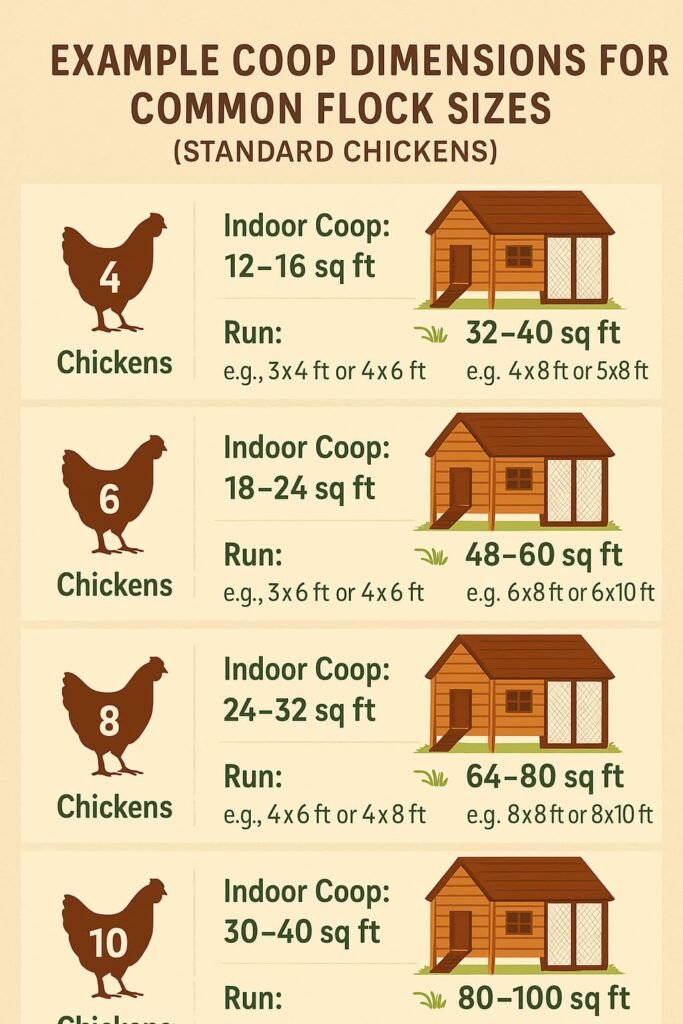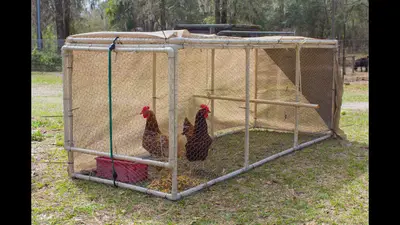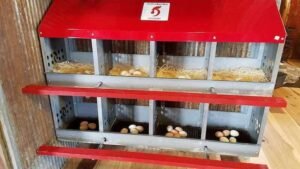Starting with backyard chickens? Great! One of the first head-scratchers you’ll face is, “Just how big does this chicken coop really need to be?” For standard chickens, plan on a bare minimum of 3-4 square feet of indoor coop space per bird, and for their outdoor run, aim for at least 8-10 square feet per bird.
Mess this up, and you’re in for a world of pecking order drama, sick birds, and general chicken chaos. Get it right, and your flock will be happy, healthy, and laying glorious eggs. These aren’t random numbers; they’re the sweet spot for comfort, health, and egg production. Knowing your chickens have ample room brings real peace of mind.
Remember, your tiny chicks will start in a brooder, but you’ll need to plan for their eventual move to the full-sized coop! If you’re still deciding when to bring your feathered friends home, check out our guide on What’s the Best Age to Start Raising Chickens?.
And before you even buy lumber, always check your local city or county ordinances! Some areas have specific minimum coop sizes, setback requirements, or limits on how many chickens you can keep. Ignoring these can lead to fines or having to tear down your hard work. For a deeper dive into regulations, see our article on Chicken Laws by State.
(Quick Note on Data: I’m sharing general guidelines. For the absolute latest data and specific recommendations, always check reputable sources like university extension offices or national poultry associations. A fantastic resource for comprehensive poultry information is eXtension.org’s Poultry Hub. They’re your go-to for cutting-edge info.)
Why Does Chicken Coop Size Really Matter?
Thinking of squeezing more birds in? I’ve been there, trying to make the numbers work. But overcrowding is a full-blown chicken disaster.
Squished chickens get stressed. Imagine living in a tiny apartment with ten roommates – not fun! For chickens, stress leads to ugly problems:
- Egg Production Dips: Stressed hens don’t lay. Their bodies say, “Too much going on to reproduce.” Fewer eggs for your breakfast. By the way, if you’re curious about egg production, you might be wondering, Do I Need a Rooster to Get Eggs?.
- Feather Picking & Fights: Bored, stressed, cramped chickens turn into bullies. Expect bald spots, nasty pecks, and a miserable flock. It’s heartbreaking.
- Diseases Spread Fast: Tight spaces with poor airflow are petri dishes. One sick bird, and your whole flock is coughing. More space helps dilute pathogens.
- Poop Piles Up: More chickens, less space means faster manure buildup. Hello, flies! Hello, stink! Hello, higher risk of foot infections. A bigger coop means easier cleaning and healthier birds.
Enough space isn’t just “nice.” It’s directly tied to their health, happiness, and your success getting those delicious eggs.
How Big Should My Chicken Coop Be? The Quick Chart
To make sizing painless, here’s a handy chart. It lists the absolute minimum space your chickens need, inside the coop and out in the run, by breed size. Remember, these are minimums. More room almost always means happier chickens (and more eggs!).
| Chicken Breed Type | Indoor Coop Space (per bird) | Outdoor Run Space (per bird) |
|---|---|---|
| Bantam Chickens | 2 sq ft | 4-5 sq ft |
| Standard Chickens | 3-4 sq ft | 8-10 sq ft |
| Heavy/Large Breeds | 4-5 sq ft | 10-12 sq ft |
Just a heads-up: These are bare minimums. If your chickens are confined 24/7, seriously consider adding an extra 1-2 square feet per bird to both indoor and outdoor spaces.
They’ll spend all their time there, which really helps their well-being and your peace of mind!
This chart is your new best friend for coop plans. Whether you’re dreaming of tiny bantams or robust, chunky breeds, these figures keep you on track. For more detailed guidelines on specific breeds and their characteristics, the American Poultry Association is an excellent resource.
Example Coop Dimensions for Common Flock Sizes (Standard Chickens)

Sometimes, knowing the per-bird square footage is just the first step. You want to know, “What does that actually look like?” Here are some practical examples for common standard chicken flock sizes, based on the minimum recommendations:
- For 4 Standard Chickens:
- Coop: 12-16 sq ft (e.g., 3×4 ft or 4×4 ft)
- Run: 32-40 sq ft (e.g., 4×8 ft or 5×8 ft)
- For 6 Standard Chickens:
- Coop: 18-24 sq ft (e.g., 3×6 ft or 4×6 ft)
- Run: 48-60 sq ft (e.g., 6×8 ft or 6×10 ft)
- For 8 Standard Chickens:
- Coop: 24-32 sq ft (e.g., 4×6 ft or 4×8 ft)
- Run: 64-80 sq ft (e.g., 8×8 ft or 8×10 ft)
- For 10 Standard Chickens:
- Coop: 30-40 sq ft (e.g., 5×6 ft or 5×8 ft)
- Run: 80-100 sq ft (e.g., 8×10 ft or 10×10 ft)
Need a Quick Calculation? Try Our Coop Size Calculator!
Want to quickly figure out the recommended space for your specific flock size? Use our simple calculator below! Just enter the number of chickens you plan to keep and select their breed size, and it will give you the recommended indoor coop and outdoor run square footage.
Chicken Coop Size Calculator
What Other Factors Affect Coop Size?
The chart offers core numbers, but chicken keeping isn't always by the book. Other factors might push you to give your birds more room. It's about tailoring space to your flock.
- Local Rules & Regulations: As mentioned in the intro, check your city or county ordinances! Some areas have specific minimum coop sizes, setback requirements, or limits on how many chickens you can keep. Ignoring these can lead to fines or having to tear down your hard work. For a comprehensive overview, don't forget to consult our Chicken Laws by State guide.
- Flock Size: Obvious, but often miscalculated. Starting with four chicks but planning more next spring? Build for the future flock. Expanding a coop later is a royal pain. If you're still figuring out your ideal flock size, especially for your family, our article How Many Chickens Do You Need for a Family of 4? can help.
- Climate (Hot vs. Cold): Scorching climate? More space and amazing ventilation are non-negotiable. Chickens need room to cool down. Freezing climates? A slightly larger coop allows more bedding for insulation, but ventilation still prevents moisture (and frostbite). Your chickens feel extreme weather too!
- Breed Temperament: Some breeds are chill (Orpingtons), others flighty (Leghorns). A mellow breed might tolerate less elbow room. Knowing your breed's personality helps you decide if you need extra space. Research can save future squabbles.
- Confinement vs. Free-Ranging: Chickens locked in their coop/run most of the time? Err on the side of more space. If they free-range daily, run size can be flexible, but coop minimums still apply. More confinement means more space to avoid boredom and stress.
- Future Expansion: My golden rule: always, always, always overestimate your space needs. You start with three cute fluffballs, then see a gorgeous Marans and need two more. Extra space from day one is easier than adding it later. Plan for the flock you might have. Chicken math is real.
Beyond the Coop: The Importance of Run Space
The coop is for sleeping and shelter. The run? That's their outdoor gym, dining room, and spa. A generous outdoor run is as crucial as the coop, maybe more so, for overall well-being.
Think of it this way: the coop is their bedroom for sleeping and laying eggs, while the run is their living room and backyard for daytime activities. Chickens spend most of their waking hours in the run, so its size and features are incredibly important.
In the run, chickens can:
- Forage: They love scratching for bugs, worms, greens. It's vital for mental stimulation and natural behavior. Keeps them busy and happy.
- Dust Bathe: How chickens clean themselves and get rid of parasites. They need a dry, loose patch of dirt. Without it, they'll be itchy and prone to parasites.
- Exercise: Running, flapping, stretching – keeps them fit and healthy. A sedentary chicken is often bored and unhealthy.
- Sunbathe: Like us, chickens love sun. It helps them absorb Vitamin D, crucial for strong bones and eggshells.
- Socialize: Bigger run means fewer squabbles, more room for everyone. Allows a natural pecking order without constant conflict.
The run is their main hang-out spot. Ample run space cuts boredom, stress, and many common chicken ailments. And don't forget predator-proofing! Bury hardware cloth around the perimeter to stop digging critters. A secure run means peace of mind for you.
Considering a Mobile Coop (Chicken Tractor)?
For those looking for flexibility, a mobile chicken coop, often called a "chicken tractor," can be a fantastic option. These coops are designed to be moved regularly, giving your flock access to fresh pasture for foraging and helping you spread manure (and control pests!) across your yard. While they offer great benefits, remember that the same space requirements per bird still apply within the tractor itself.
What Else Should Be Inside a Chicken Coop?
Overall square footage is vital, but how you set up the inside of your coop? Huge for comfort and health. These overlooked details make or break your flock's well-being.
- Roosting Bars: Chickens sleep high at night. Provide 8-10 inches of roosting space per standard chicken. This gives them room without crowding, reducing stress and frostbite. Bars should be sturdy, rounded, and higher than nesting boxes. Why higher? Chickens sleep in the highest spot; you don't want poop in egg beds!
- Nesting Boxes: Cozy nooks for eggs. Rule of thumb: 1 nesting box for every 3-4 hens. Six hens? Two boxes are enough. More isn't always better; they often use the same favorite. Enough clean, private spots encourage consistent laying and reduce breakage.
- Ventilation: The unsung hero. Often forgotten, but critical. Good airflow stops ammonia buildup (from droppings), cuts humidity (preventing frostbite), and ensures fresh air. You need high vents for stale air out, low vents for fresh air in. Vents must be predator-proofed with hardware cloth, and avoid direct drafts on roosting chickens. Good airflow prevents respiratory issues and keeps the coop healthy – vital for happy, breathing chickens.
What Are Common Coop Sizing Mistakes?
Learning from others' screw-ups saves heartache (and cash!). Here are common pitfalls for coop size:
- Overcrowding from Day One: The top mistake. Don't squeeze too many birds into a small space. It's a fast track to stress, fighting, and disease. Simply unfair to the birds.
- Ignoring the Run: People focus on coop footprint, forgetting chickens spend most waking hours outside. A huge, fancy coop with a tiny run? Still unhappy chickens. Outdoor space is equally, if not more, important.
- Skimping on Ventilation: A coop can be massive, but if the air is stagnant and stinky, it's unhealthy. Don't cut corners on vents! Poor ventilation is a silent killer of chicken health.
- Not Planning for Growth: You start with 3 cute chicks. Then you see a gorgeous Marans and need one. If your coop can't expand, you're stuck. Always build a little bigger. "Chicken math" is real; your flock will likely grow.
- Weak Predator Proofing: What's the point of a spacious coop if a raccoon waltzes in? Double-check every opening, vent, door. Use strong hardware cloth (not flimsy chicken wire!) and sturdy latches. A spacious coop means nothing if it's not secure.
Confession: my first coop was a cute, pre-made thing. I thought it'd be perfect for four hens. Within a month, I battled feather picking, dirty eggs, and general chicken discontent. Harsh lesson: space isn't a suggestion; it's non-negotiable for a thriving flock. For more on avoiding common pitfalls, check out our full guide: Mistakes Every First-Time Chicken Keeper Makes.
How I Figured Out the Right Coop Size for My Flock
When I first started, conflicting advice on coop size overwhelmed me. I read articles, watched videos, still bewildered. My "aha!" moment wasn't from a chart. It hit me when I stopped thinking purely about numbers and started thinking about their natural behaviors.
I watched them. How they loved to scratch, dust bathe, chase bugs. They needed room to stretch their wings – literally. So, instead of the smallest coop that "fit" my initial three hens, I grabbed a pencil. I sketched a design with ample indoor space (a solid 4 sq ft per bird, no compromises) and a ridiculously huge outdoor run (closer to 15 sq ft per bird, why not?). I even added extra roosting bars and nesting boxes, just in case "chicken math" fever struck.
Biggest lesson: visualize them living in the space. Could they all eat comfortably? Roost without squabbling? Enough loose dirt for a proper dust bath? Putting myself in their tiny, feathered shoes, I built a coop that's served my flock beautifully for years. It handled new additions without a hitch. Seeing them content makes initial planning feel like a breeze. It felt like a big project, but the payoff in happy, healthy hens and steady fresh eggs? Absolutely, 100% worth it.
Frequently Asked Questions About Chicken Coop Size
Can chickens have too much space?
Rarely. A vastly oversized coop can make a small flock feel insecure or colder. However, a run can almost never be too big.
What happens if a coop is too small?
Overcrowding causes stress, aggression, reduced egg production, increased disease risk, and unsanitary conditions.
Can I keep chickens in a shed?
Yes, if it meets space requirements, has excellent ventilation, proper roosting bars, nesting boxes, and is securely predator-proofed.
How often do I need to clean based on coop size?
A larger coop may require less frequent full clean-outs. However, daily spot cleaning under roosts is always recommended.
What is the ideal height for a chicken coop?
Around 6-7 feet, allowing you to stand comfortably for cleaning and providing vertical space for roosting bars.
How many chickens can fit in a 4x8 coop?
A 4x8 foot coop (32 sq ft) can house 8-10 standard chickens or up to 16 bantams.
Do chickens need a run, or can they free-range?
A secure run is highly recommended for safety, though chickens can free-range with caution and supervision.
What about adding a dust bath area inside the coop?
It's better to have a dust bath in the run. Inside the coop, it creates dust and humidity, harming respiratory health.
How many chickens per square meter?
For standard chickens, aim for 0.28-0.37 square meters (0.2-0.28 for bantams, 0.37-0.46 for heavy breeds) of indoor coop space per bird. For outdoor run space, target 0.74-0.93 square meters per standard chicken.
Can chickens stay in the run at night?
No, chickens should always be secured inside a predator-proof coop at night. Runs offer daytime protection but are rarely secure enough to keep out nocturnal predators like raccoons or foxes.
The Bottom Line: Sizing Your Coop for Happy Hens
Choosing the right coop size is one of the most crucial choices you'll make. It's not just about minimums; it's about building a comfortable, safe, stimulating home for your chickens to thrive.
Put their well-being first, and I promise, you'll be rewarded. You'll have a healthy, productive, joyful flock. And remember my favorite advice: when in doubt, go bigger! Your chickens (and your future self, avoiding drama) will thank you. Happy hens mean happy chicken keepers, every single time!

Oladepo Babatunde is the founder of ChickenStarter.com. He is a backyard chicken keeper and educator who specializes in helping beginners raise healthy flocks, particularly in warm climates. His expertise comes from years of hands-on experience building coops, treating common chicken ailments, and solving flock management issues. His own happy hens are a testament to his methods, laying 25-30 eggs weekly.



